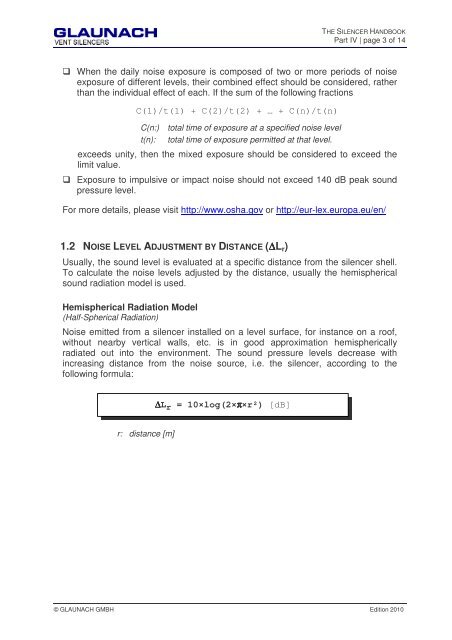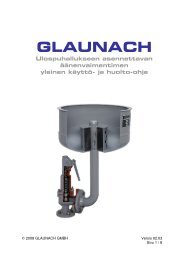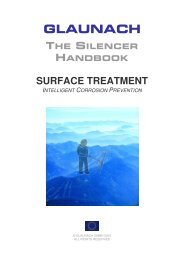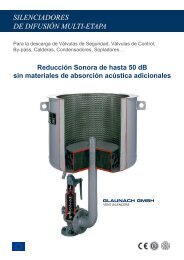1. acoustic dimensioning - GLAUNACH Vent Silencers
1. acoustic dimensioning - GLAUNACH Vent Silencers
1. acoustic dimensioning - GLAUNACH Vent Silencers
Create successful ePaper yourself
Turn your PDF publications into a flip-book with our unique Google optimized e-Paper software.
THE SILENCER HANDBOOK<br />
Part IV | page 3 of 14<br />
When the daily noise exposure is composed of two or more periods of noise<br />
exposure of different levels, their combined effect should be considered, rather<br />
than the individual effect of each. If the sum of the following fractions<br />
C(1)/t(1) + C(2)/t(2) + … + C(n)/t(n)<br />
C(n:) total time of exposure at a specified noise level<br />
t(n): total time of exposure permitted at that level.<br />
exceeds unity, then the mixed exposure should be considered to exceed the<br />
limit value.<br />
Exposure to impulsive or impact noise should not exceed 140 dB peak sound<br />
pressure level.<br />
For more details, please visit http://www.osha.gov or http://eur-lex.europa.eu/en/<br />
<strong>1.</strong>2 NOISE LEVEL ADJUSTMENT BY DISTANCE (∆Lr)<br />
Usually, the sound level is evaluated at a specific distance from the silencer shell.<br />
To calculate the noise levels adjusted by the distance, usually the hemispherical<br />
sound radiation model is used.<br />
Hemispherical Radiation Model<br />
(Half-Spherical Radiation)<br />
Noise emitted from a silencer installed on a level surface, for instance on a roof,<br />
without nearby vertical walls, etc. is in good approximation hemispherically<br />
radiated out into the environment. The sound pressure levels decrease with<br />
increasing distance from the noise source, i.e. the silencer, according to the<br />
following formula:<br />
r: distance [m]<br />
∆L r = 10×log(2×π×r²) [dB]<br />
© <strong>GLAUNACH</strong> GMBH Edition 2010








